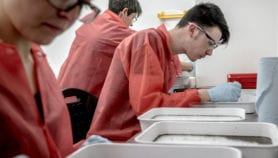By: Priya Shetty
Send to a friend
The details you provide on this page will not be used to send unsolicited email, and will not be sold to a 3rd party. See privacy policy.
A group of scientists is meeting this week as part of an initiative that aims to increase the role public sector research plays in developing international biotechnology regulations.
The move is a response to the lack of public sector representation in negotiations on the Cartagena Protocol on Biosafety, which came into force in 2003.
The protocol aims to protect biological diversity from potential risks posed by genetically modified (GM) organisms, such as the movement of genes from GM to non-GM crops (see Warning issued on GM maize imported to Mexico).
The protocol is of special interest to developing countries, which hold most of the world’s biological diversity, and which could benefit greatly from the products of biotechnology, such as increased food supply and better healthcare.
The absence of public sector involvement in the negotiations inspired the creation in 2004 of the Public Research and Regulation foundation, which insists that public sector input is as important as that of large multinationals and non-governmental organisations.
It is this foundation that has gathered researchers for a two-day meeting starting today (3 March) in St. Louis, United States.
The foundation aims to ensure that researchers involved in governmental, academic and international research institutes take part in future discussions of the uses of biotechnology.
In particular, it wants the public sector to be represented at the second meeting of the parties to the Cartagena Protocol, due to begin on 30 May 2005, in Montreal, Canada.
In preparation for that meeting, the foundation is using this week’s gathering to brief public sector scientists on the background and implementation of the Cartagena Protocol and the ongoing negotiations over biotechnology regulation.
Speaking on behalf of the initiative’s steering committee, Piet van der Meer told SciDev.Net that public sector representation would be important “to inform negotiating parties of the reasons for and objectives of public research, such as contributing to sustainable food production by developing crops that resist disease or drought”.
Public sector involvement would also be crucial for helping governments understand the effect that proposed changes to international rules would have on public research, he said.
According to the Public Research and Regulation foundation, the lack of public-sector representation at previous negotiations has perpetuated the myth that modern biotechnology is the exclusive domain of a handful of large, Western multinationals.
In a recent article in Nature Biotechnology, Joel Cohen, director of the programme for biosafety systems at the US-based International Food Policy Research Institute, argued that in developing countries public research is making progress in using modern biotechnology to serve the needs of the poor.
Ultimately, said Cohen, “although some commercially developed GM products have a role to play, GM crops developed by public research institutes should be most relevant to local needs in poor countries”.
“The private sector can only do so much,” Cohen told SciDev.Net. “It is the voice of local [public research and regulatory] experience that must speak now. Others are talking from political or economic agendas alone.”
“NGOs can provide insight and experience as to local community needs. The private sector can reach these communities in a few cases, and they do have a role to play. But, it is the public sector research that will have to be proven, or die from lack of impact.”
Both van der Meer and Cohen emphasised that regulations need to take into account the inherent differences in public and private research.
Van der Meer pointed out that the Cartagena Protocol’s regulations on introduction of GM material into the environment, for example, do not distinguish between whether the project is a small-scale confined field trial or a large-scale commercial application. Cohen agreed, adding that the stringent risk analysis and extensive data demanded by the protocol early on in a study may halt public research projects prematurely.
If the public sector is not more involved in negotiations, warned Cohen, the implications for the developing world would be that “more and more work will be put into defining, understanding, and implementing the protocol and its articles, than in actually seeing if such technologies will provide social value”.
Getting the voice of the public research sector heard at the May meeting is just the first step, says the foundation. The next phase will be the long-term involvement of the public sector in biosafety negotiations through working groups, meetings and newsletters.
Read more about this topic in SciDev.Net’s GM crops dossier.
Link to Public Research and Regulation foundation
Link to the Cartagena Protocol on Biosafety













